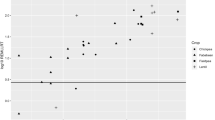Abstract
Plant breeders frequently evaluate large numbers of entries in field trials for selection. Generally, the tested entries are related by pedigree. The simplest case is a nested treatment structure, where entries fall into groups or families such that entries within groups are more closely related than between groups. We found that some plant breeders prefer to plant close relatives next to each other in the field. This contrasts with common experimental designs such as the α-design, where entries are fully randomized. A third design option is to randomize in such a way that entries of the same group are separated as much as possible. The present paper compares these design options by simulation. Another important consideration is the type of model used for analysis. Most of the common experimental designs were optimized assuming that the model used for analysis has fixed treatment effects. With many entries that are related by pedigree, analysis based on a model with random treatment effects becomes a competitive alternative. In simulations, we therefore study the properties of best linear unbiased predictions (BLUP) of genetic effects based on a nested treatment structure under these design options for a range of genetic parameters. It is concluded that BLUP provides efficient estimates of genetic effects and that resolvable incomplete block designs such as the α-design with restricted or unrestricted randomization can be recommended.
Similar content being viewed by others
References
Bueno JSD, Gilmour SG (2003) Planning incomplete block experiments when treatments are genetically related. Biometrics 59:375–381
Cervantes-Martinez CT, Frey KJ, White PJ, Wesenberg DM, Holland JB (2001) Selection for greater β-glucan content in oat grain. Crop Sci 41:1085–1091
Falconer DS, Mackay TFC (1996) Introduction to quantitative genetics. 4th edn. Prentice Hall, Harlow
Gilmour AR, Cullis BR, Verbyla AP (1997) Accounting for natural and extraneous variation in the analysis of field experiments. J Agric Biol Environ Stat 2:269–293
Littell RC, Milliken GA, Stroup WW, Wolfinder RD (1996) SAS System for Mixed Models. SAS Institute, Cary
Lush JL (1947) Family merit and individual merit as bases for selection. Am. Nat. 81:241–261 and 362–379
Panter DM, Allen FL (1995) Using best linear unbiased predictions to enhance breeding for yield in soybean. 2. Selection of superior crosses from a limited number of yield trials. Crop Sci 35:405–410
Patterson HD, Williams ER (1976) A new class of resolvable incomplete block designs. Biometrika 63:83–92
Patterson HD, Thompson (1971) Recovery of inter-block information when block sizes are unequal. Biometrika 58:545–554
Persson BT, Andersson B (2004) Accuracy of single- and multi-trait REML evaluation of data including non-random missing records. Silvae Genetica 53:135–139
Piepho HP, Büchse A, Emrich K (2003) A hitchhiker’s guide to the mixed model analysis of randomized experiments. J Agron Crop Sci 189:310–322
Piepho HP, Möhring J (2006) Selection in cultivar trials—is it ignorable? Crop Sci 146:193–202
Qiao CG, Basford KE, DeLacy IH, Cooper M (2000) Evaluation of experimental designs and spatial analyses in wheat breeding trials. Theor Appl Genet 100:9–16
Soh AC, Gan HH, Wong G, Hor TY, Tan CC (2003) Estimates of within family genetic variability for clonal selection in oil palm. Euphytica 133:147–163
Whitaker D, Williams ER, John JA (2006) CycDesigN: a package for computer generation of experimental designs. http://www.cycdesign.co.nz
Williams ER, John JA (1999) Construction of resolvable designs with nested treatment structure. Biom J 41:341–349
Williams ER, Matheson AC, Harwood CE (2002) Experimental design and analysis for tree improvement, 2nd edn. CSIRO, Canberra
Wu J, Jenkins JN, McCarty JC, Wu D (2006) Variance component estimation using the additive, dominance, and additive x additive model when genotypes vary across environments. Crop Sci 46:174–179
Yang RC (2002) Likelihood-based analysis of genotype-environment interactions. Crop Sci 42:1434–1440
Acknowledgments
The first author was supported within the breeding and informatics (BRAIN) project of the genome analysis of the plant biological system (GABI) initiative (www.brain.de). We thank all breeders of GABI-BRAIN who have provided data and information on their field trial designs. Three referees are thanked for exceptionally constructive and detailed comments.
Author information
Authors and Affiliations
Corresponding author
Additional information
Communicated by M. Cooper.
Rights and permissions
About this article
Cite this article
Piepho, H.P., Williams, E.R. A comparison of experimental designs for selection in breeding trials with nested treatment structure. Theor Appl Genet 113, 1505–1513 (2006). https://doi.org/10.1007/s00122-006-0398-8
Received:
Accepted:
Published:
Issue Date:
DOI: https://doi.org/10.1007/s00122-006-0398-8




